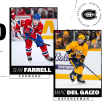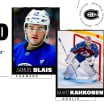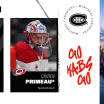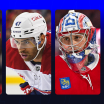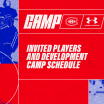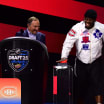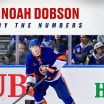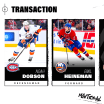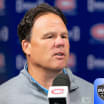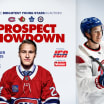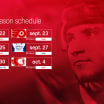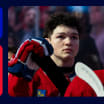Norlinder showing promising progress in Sweden
Special contributor Marc Dumont takes a closer look at 2019 draftee Mattias Norlinder's impressive development to date
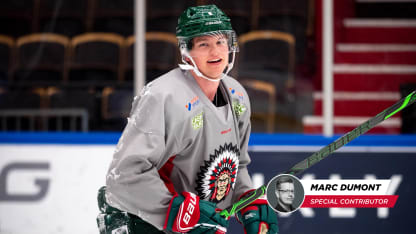
Not only has he shown a commitment to improving his performance every year, he also possesses one of the most exciting skillsets in a prospect pool that's already overflowing with talent.
Elite skating? Check.
Fantastic vision? Check.
Great shot from the point? Check.
Ability to create time and space for his teammates and himself with his ability to dangle the puck with the best of them while sporting a classic hockey flow? Check!
Let's take a closer look at how the high-flying defenseman has progressed since his draft year, with a focus on some of the statistics driving his success.
Draft Season (+1)
He's quickly climbed the ranks among the organization's best prospects currently playing outside the NHL, but -- unlike his skating -- things haven't always gone smoothly for Norlinder when it comes to his hockey aspirations.
He was confronted with the harsh realities of the NHL Draft early in his life, going undrafted in his first eligible season despite scoring at a relatively impressive rate.
With eight goals in 35 games in 2017-18 with MODO (SuperElit, U20), Norlinder finished the season with the third-best goals-per-game ratio among all defensemen under the age of 18. It wasn't enough to get him drafted, but it was enough for some scouting departments to take notice.
The following season in the J20SuperElite, Norlinder's points-per-game ratio jumped from a paltry 0.36 points-per-game all the way to 0.7, the eight best points-per-game ratio among all defensemen under the age of 19. He finished the season in style, earning team MVP honours for his playoff performance.
He also played 14 games with MODO's first team, scoring two goals and four assists in 14 games, an excellent result relative to his age group, where he finished third in points per game among all players, forwards included.
He followed up his draft season with yet another increase in production, paired with a significant uptick in competition due to his full-time graduation to the Allsvenskan with MODO.
In 34 games, Norlinder managed to score seven goals and 11 assists, once again finishing among the highest-scoring players in his age group.
But the best was still yet to come for the young defender.
While Norlinder showed encouraging signs following his selection in the draft, in order to take the next step, Norlinder would have to join a team playing in the Swedish Hockey League.
Enter Frölunda HC, the same club that took over Artturi Lehkonen's development following his second-round selection by the Canadiens in 2013, and the same club that produced some of the best European talents in the NHL, including Erik Karlsson, Lars Eller, Daniel Alfredsson, Henrik Lundqvist, and Rasmus Dahlin, among others.
"Norlinder's transition from HockeyAllsvenskan to the SHL has been completely seamless," explains Uffe Bodin, editor-in-chief of
Hockeysverige.se
. "His fluid, effortless skating and intelligence with and without the puck make him a player that stands out. He might not have gotten paid offensively for his strong start to the season, but it's probably only a matter of time before his instincts in the offensive zone pay dividends."
It's a glowing review shared by the few experts that have had a chance to follow Norlinder's progression since his draft year, including
Patrik Bexell
, an undisputed authority when it comes to European prospects drafted by the Canadiens organization. Like Bodin, Bexell sees a player who not only made a seamless transition to a more difficult league but did so with aplomb, improving upon several crucial areas in the process.
"Norlinder is calmer in the defensive zone," said Bexell. "He is strong on the puck, he has gotten bigger and his balance is much better this season in the SHL compared to last year in HockeyAllsvenskan."
What's more, Bexell also notes a significant uptick in Norlinder's defensive game.
"You can tell that he is paying more attention to the defensive game and the details involved, in order to become a better overall defenseman," said Bexell. "He takes a lot of pride in his defensive game."
Statistically speaking
Player comparisons are some of the most difficult projections to make in the sports world.
Many of the comparisons rely on physical similarities: a tall D-man will draw Chris Pronger comparisons, whereas a smaller winger will invariably earn "future Martin St. Louis or Brendan Gallagher" tags prior to the draft.
And then there are style comparisons, which often rely on quotes from the athletes in question. Norlinder credits Drew Doughty and Victor Hedman as influences on his game, as evidenced by his smooth-skating and high-end stickhandling.
There's absolutely nothing wrong about modeling your game after Norris-winning defensemen. In fact, ideally, that's exactly the type of defensemen you want your young blue-liners emulating.
But it's also setting the bar as high as possible, which leads to an unreasonable amount of expectations.
And while there's certainly something to be said about matching physical attributes and styles, there are simply too many factors to consider when comparing players to rely on size alone.
Points, however, tend to be a universal language, even for defensemen. As long as the prospect in question is receiving a generous dose of ice time -- including power play minutes -- against an age-appropriate level of competition, they should be producing at a certain level to be considered legitimate high-end prospects.
It's not always the case; some prospects may be playing in better leagues, others may not be receiving optimal ice time, but generally speaking, it's a good indication of a prospect's NHL potential.
For this, we turn to NHL Draft Consultant and Data Scientist, Byron Bader, who developed a prospecting model based on
NHL Equivalency
(NHLe), a formula that allows us to compare production from an inferior league to the NHL, which, in turn, gives us a better idea of how it may translate once they make it to the big leagues.
In Norlinder's case, the closest comparable happens to not only share a similar production rate, but an eerily similar backstory as well, given that they both share the same given name and a virtually identical roadmap, having spent two years in Sweden's second-best league before making the jump to the SHL.
Of course, there are no guarantees that Norlinder will eventually establish himself as one of the best second-pairing players in the League like Mattias Ekholm, but all signs point to him having the potential to reach those heights.
"He is a player that can do the unthinkable rather than the unexpected," said Bexell, noting that Norlinder has quickly become a fan favourite in Gothenburg.
It remains to be seen if Norlinder can continue to defy expectations, but if his impressive progress since his draft season is any indication, the best is yet to come.
Photo credit: [Frölunda Indians]
Prospect comparison via [Byron Bader]

